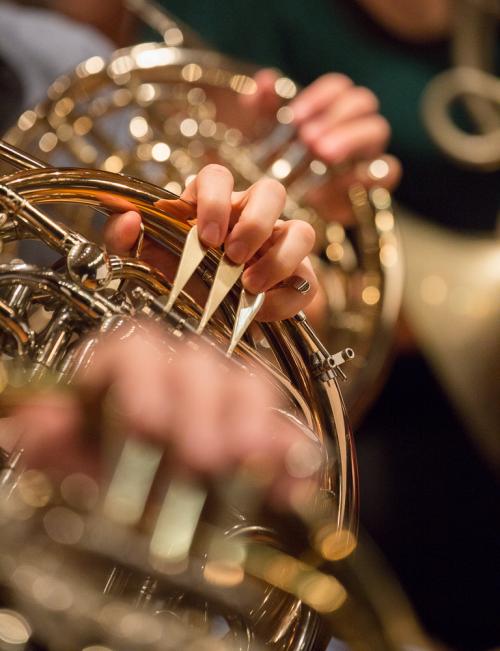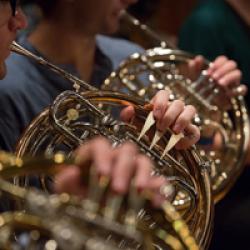 MIT Wind Ensemble, Frederick Harris, Jr., music director, Jamshied Sharifi, ’83, guest composer, MITWE alumni, guest performers, featuring Sharifi’s Awakening, composed for MITWE in 2012. MITWE’s premiere of this piece is the subject of the 2014 Emmy-winning documentary “Awakening: Evoking the Arab Spring Through Music," aired on PBS. An excerpt from the documentary will be shown. Also on the program is Holst, Second Suite in F; Grainger, The Gum-Suckers March; and Francaix's Eleven Variations on a Theme of Haydn. 8pm, Kresge Auditorium. General admission $5; Free, in advance via Eventbrite, to MIT community with MIT email address. Tickets at http://mitmta.eventbrite.com and at the door.
MIT Wind Ensemble, Frederick Harris, Jr., music director, Jamshied Sharifi, ’83, guest composer, MITWE alumni, guest performers, featuring Sharifi’s Awakening, composed for MITWE in 2012. MITWE’s premiere of this piece is the subject of the 2014 Emmy-winning documentary “Awakening: Evoking the Arab Spring Through Music," aired on PBS. An excerpt from the documentary will be shown. Also on the program is Holst, Second Suite in F; Grainger, The Gum-Suckers March; and Francaix's Eleven Variations on a Theme of Haydn. 8pm, Kresge Auditorium. General admission $5; Free, in advance via Eventbrite, to MIT community with MIT email address. Tickets at http://mitmta.eventbrite.com and at the door.
About Awakening:
In an effort to motivate his students to think about the Arab Spring, Frederick Harris, director of the Wind and Jazz Ensembles at MIT, approached composer Jamshied Sharifi, MIT class of '83, in the spring of 2011 with the idea of composing a piece related to the movement. It was just months after Mohamed Bouazizi’s self-immolation in Tunisia that launched the ongoing Arab Spring. Born to an Iranian father and American mother and having previously studied and taught at MIT, Sharifi was uniquely qualified to take on this project. “For those of us with Persian heritage who watched the earlier political protests in Iran, initially with hope and then with bitter disappointment, the success of the civil movements in Tunisia, Egypt, and Libya were especially gratifying,” said Sharifi. “The labor of developing effective and responsive political systems in those three countries still remains. But something in the Middle East has undeniably changed. And I tried to honor that shift in this piece.”
“Awakening is in three movements.” explains Sharifi: “I. Maghreb/Bouazizi/The Uprisings, II. Reflection: Let Each One Hear Her Own Thoughts, and III. Ahead: The Real Transformation Has Barely Begun. The first movement gives us a sense of place, utilizing maqam Hijaz (a mode often associated with the deep desert), and continues in a somewhat programmatic fashion, touching on the tragic event that ignited the protests, and continuing into the propagation of the revolutions. The second movement is a respite; a chance to contemplate what has happened. And the third hopes to energize and inspire the work that is to come.”
The piece was documented by MIT Video Productions in a 30-minute video that aired on PBS WGBH2 and that was subsequently nominated and awarded a New England Emmy.



 MIT Wind Ensemble, Frederick Harris, Jr., music director, Jamshied Sharifi, ’83, guest composer, MITWE alumni, guest performers, featuring Sharifi’s Awakening, composed for MITWE in 2012. MITWE’s premiere of this piece is the subject of the 2014 Emmy-winning documentary “Awakening: Evoking the Arab Spring Through Music," aired on PBS. An excerpt from the documentary will be shown. Also on the program is Holst, Second Suite in F; Grainger, The Gum-Suckers March; and Francaix's Eleven Variations on a Theme of Haydn. 8pm, Kresge Auditorium. General admission $5; Free, in advance via Eventbrite, to MIT community with MIT email address. Tickets at
MIT Wind Ensemble, Frederick Harris, Jr., music director, Jamshied Sharifi, ’83, guest composer, MITWE alumni, guest performers, featuring Sharifi’s Awakening, composed for MITWE in 2012. MITWE’s premiere of this piece is the subject of the 2014 Emmy-winning documentary “Awakening: Evoking the Arab Spring Through Music," aired on PBS. An excerpt from the documentary will be shown. Also on the program is Holst, Second Suite in F; Grainger, The Gum-Suckers March; and Francaix's Eleven Variations on a Theme of Haydn. 8pm, Kresge Auditorium. General admission $5; Free, in advance via Eventbrite, to MIT community with MIT email address. Tickets at